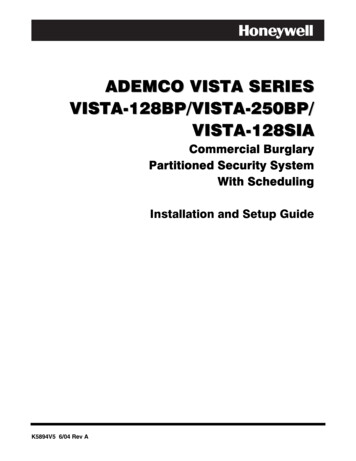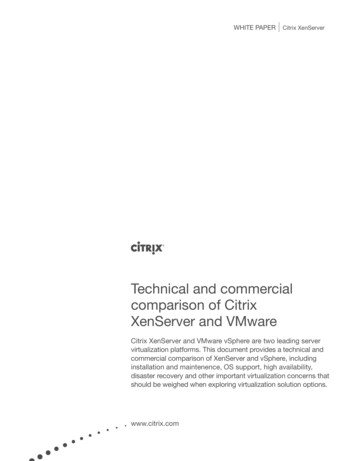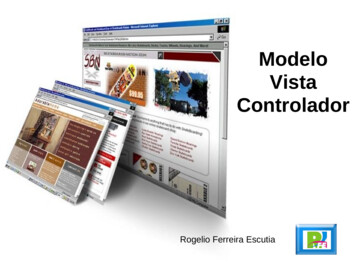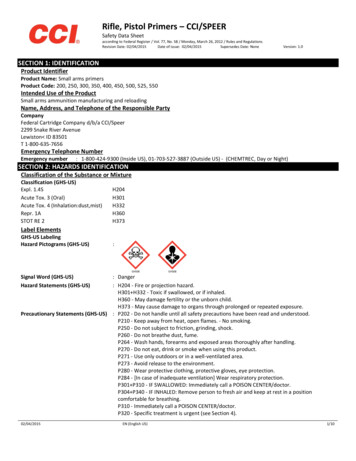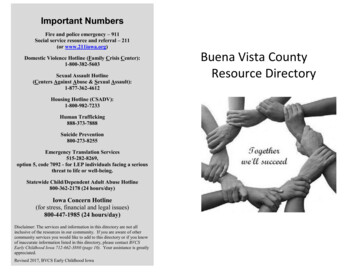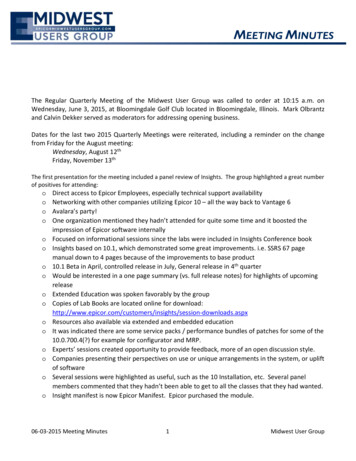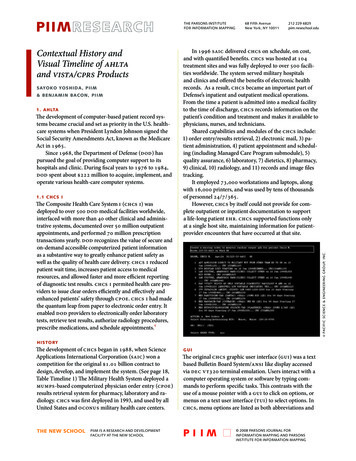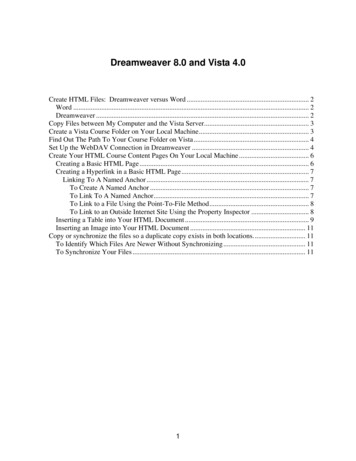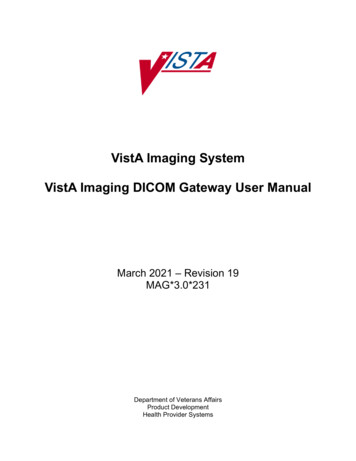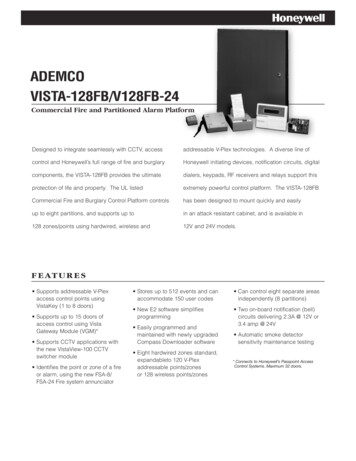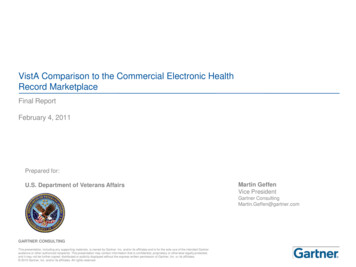
Transcription
VistA Comparison to the Commercial Electronic HealthRecord MarketplaceFinal ReportFebruary 4, 2011Prepared for:U.S. Department of Veterans AffairsMartin GeffenVice PresidentGartner ConsultingMartin.Geffen@gartner.comGARTNER CONSULTINGThis presentation, including any supporting materials, is owned by Gartner, Inc. and/or its affiliates and is for the sole use of the intended Gartneraudience or other authorized recipients. This presentation may contain information that is confidential, proprietary or otherwise legally protected,and it may not be further copied, distributed or publicly displayed without the express written permission of Gartner, Inc. or its affiliates. 2010 Gartner, Inc. and/or its affiliates. All rights reserved.
Table of Contents Executive Summary Project Objectives and Approach Electronic Health Record Systems Marketplace VistA Overall Findings VistA Capability Assessment Appendices 2011 Gartner, Inc. and/or its affiliates. All rights reserved.Gartner is a registered trademark of Gartner, Inc. or its affiliates.1
Executive Summary 2011 Gartner, Inc. and/or its affiliates. All rights reserved.Gartner is a registered trademark of Gartner, Inc. or its affiliates.2
Objective and Approach Project Objective– The Department of Veterans Affairs (VA) engaged Gartner to develop a fact-based assessmentof how VistA capabilities compare to those that are found in leading commercial off-the-shelf(COTS) Electronic Health Record (EHR) products. Approach– Gartner applied an evaluation framework which is based on Gartner research, Gartner‘s definitionof an EHR and methodologies (e.g., Magic Quadrant, Generations Model, Hype Cycle) tocompare VistA clinical functionality to that of the EHR COTS products.– The evaluation framework compared VistA capabilities to those of COTS products in three majorcategories: Core Clinical Capabilities Support for Key Care Venues Support for select Stakeholders 2011 Gartner, Inc. and/or its affiliates. All rights reserved.Gartner is a registered trademark of Gartner, Inc. or its affiliates.3
Key Points VistA delivers value through a set of core EHR functions VistA has more than core capabilities in some areas, but innovation and agility areincreasingly difficult VistA core capabilities lag COTS EHR solutions VistA support for care venues generally lags COTS EHR solutions, but is moreadvanced than COTS solutions in some care venues VistA lags leading COTS EHR products with respect to specific stakeholder support The EHR COTS market is saturated, consolidating, and innovating 2011 Gartner, Inc. and/or its affiliates. All rights reserved.Gartner is a registered trademark of Gartner, Inc. or its affiliates.4
VistA Delivers Value Through a Set of Core EHR FunctionsValue DeliveredCore Functionality Notwithstanding its limitations, VistA has deliveredsignificant benefits to VA, its providers, and care of itspatients. During its early years, VistA provided advancedcapabilities compared to what was generally availableat that time. Users of VistA have great confidence in the system‘sability to meet their needs. Today, the COTS EHR market has overtaken VistA interms of overall functionality. Clinicians have built upon their long experience withVistA to develop outcomes with templates and tools tostreamline their activities, capture of extensive data,and implementation of key reminders. Gartner assessed the seven leaders in the marketplace against our Computer-based Patient Record(CPR) Generations model and found that all of thesevendors provide a Generation 3 product. VistA support for data capture and reporting allows theVA to consistently report very high conformance withcritical performance measures. The data has allowedthe VA to conduct extensive analytics to investigateand report on the efficacy of programs of care. Based on a high level Generations Assessment, wewould estimate that VistA is more than a Generation 1EHR and may in fact be a Generation 2 EHR but is nota Generation 3 EHR. While the key clinician facing module, CPRS , providesa graphical user interface: VA clinical leadership reports that the availability ofVistA supports the VA‘s ability to recruit and retainmedical staff. 2011 Gartner, Inc. and/or its affiliates. All rights reserved.Gartner is a registered trademark of Gartner, Inc. or its affiliates.5–It is not as intuitive or easy to use as those of someleading COTS solutions, and–Other primary modules have a text based ‗scrolland roll‘ interface which has a steep learning curve.
VistA Has More than Core Capabilities in Some Areas, but Innovation and AgilityAre Increasingly DifficultCapability Beyond EHRProduct Leadership and Direction VistA offers a flexible toolkit for customizingthe application to specific facility and providerneeds. VA‘s users and leadership continue to provideideas to enhance VistA functionality. While VA has consolidated core developmentactivities to realize increased efficiency andquality, decentralized customization andinadequate governance inhibits the VA‘s abilitydrive sustained innovation for VistA across theenterprise. There is a lack of standardization and complexupgrade and release processes. VistA meets Gartner‘s definition of a megasuiteproduct which includes:–Advanced Clinical Information Suite–Patient Access–Revenue Cycle Management–Clinical and Business Intelligence These dynamics limit the VA‘s ability to rapidlyidentify, design, develop, and deploy advancednew features for VistA and may hamper futureefforts to re-architect or develop an entirelynew system. While VistA provides a broad product portfolioGartner does not consider it a maturemegasuite since at least some of the over 130VistA applications lack functional depth. 2011 Gartner, Inc. and/or its affiliates. All rights reserved.Gartner is a registered trademark of Gartner, Inc. or its affiliates.6
VistA Core Capabilities Lag COTS EHR Solutions VistA compares favorably with COTS EHR solutions with regard to technical capabilities such assystem management, data model and interoperability. VistA lags COTS EHR solutions with regard to key clinical functionality such as clinical decisionsupport, clinical display, and workflow.VistACOTSAverageLeadingCOTSSystem Management222Data Model222Interoperability111Workflow023Clinical Decision Support033Clinical Documentation1332 Exceeds core capabilitiesClinical Display022Meets much of the3 extended capabilitiesOrders Management2334 Meets all capabilitiesCore Capabilities 2011 Gartner, Inc. and/or its affiliates. All rights reserved.Gartner is a registered trademark of Gartner, Inc. or its affiliates.7Does not meet core0 capabilities1 Meets core capabilities
VistA Support for Care Venues Generally Lags COTS Solutions, but Is MoreAdvanced than COTS Solutions in Some Care Venues There are no care venue-specific modules in VistA. VistA has been configured to support a number of carevenues. In those areas where the COTS vendors have focused (Med Surg, ED, OR), VistA does not compare asfavorably with COTS Solutions. VistA‘s ability to provide a configured solution for the care venues where vendors have traditionally notfocused as much (e.g., Long Term Care , Mental / Behavioral Health, Home Health), has allowed VistA toprovide equivalent or better support.VistACOTSAverageLeadingCOTSMedical / Surgical Wards233Emergency Department123Intensive Care Unit023Outpatient Clinics113Hospital Pharmacy2332 Exceeds core capabilitiesOperative Environment002Meets much of the3 extended capabilitiesOther Relevant Care Venues1004 Meets all capabilitiesCare Venues 2011 Gartner, Inc. and/or its affiliates. All rights reserved.Gartner is a registered trademark of Gartner, Inc. or its affiliates.Does not meet core0 capabilities1 Meets core capabilities8
VistA Lags Leading COTS EHR Products with Respect to Specific StakeholderSupport VistA provides more support to patients than average COTS EHR products, but not as much asleading products It provides good support for nephrologists compared to COTS EHR products, but its support foroncologists is not as extensive as that of COTS EHR productsStakeholdersVistACOTS AverageLeading COTSPatientsxx Oncologistsxx Nephrologists ObstetriciansN/Ax PediatriciansN/A 2011 Gartner, Inc. and/or its affiliates. All rights reserved.Gartner is a registered trademark of Gartner, Inc. or its affiliates.9 Provides focusedsupportx Does not providefocused support
The EHR COTS Market is Saturated, Consolidating, and Innovating The EHR COTS market is highly saturated and is consolidating to a small number ofleading vendors. To continue to experience growth, these vendors are developing―megasuites‖ by:– Broadening their product lines by seeking to expand the capability modules of their EHR systems(for example, by improving their operating room capabilities or adding specialty-specific modulessuch as oncology)– Updating or adding nonclinical capabilities (such as clinical and business intelligence, revenuecycle, or bed management). There is no perceived or real need to compete with other products in the market. While VistA certainly meets the criteria for a megasuite product in terms of breadth itdoes not appear to have as much depth of functionality as COTS megasuite products. There is no formal process for investigating or analyzing market trends in order tocreate a VistA product roadmap that keeps pace with COTS solutions. The functional gap between VistA and COTS solutions is likely to grow due the rapidpace of innovation in the commercial market. 2011 Gartner, Inc. and/or its affiliates. All rights reserved.Gartner is a registered trademark of Gartner, Inc. or its affiliates.10
Project Objectives and Approach 2011 Gartner, Inc. and/or its affiliates. All rights reserved.Gartner is a registered trademark of Gartner, Inc. or its affiliates.11
Project Objective The Department of Veterans Affairs (VA) engaged Gartner to develop a fact-basedassessment of how VistA capabilities compare to those that are found in leadingcommercial off-the-shelf (COTS) Electronic Health Record (EHR) products. Gartner applied an evaluation framework which is based on Gartner research, Gartner‘sdefinition of an EHR and methodologies (e.g., Magic Quadrant, Generations Model,Hype Cycle) to compare VistA clinical functionality to that of the EHR COTS products. The evaluation framework compared VistA capabilities to those of COTS products inthree major categories: Core Clinical Capabilities Support for Key Care Venues Support for select Stakeholders 2011 Gartner, Inc. and/or its affiliates. All rights reserved.Gartner is a registered trademark of Gartner, Inc. or its affiliates.12
Project Approach Gartner conducted this assessment from late December 2010 to early February 2011according to the following six key steps:1.Document review VA provided information regarding VistA capabilities and architecture Gartner conducted research into VistA and private sector extensions of the FOIA VistA suite2.Questionnaire and clarification VA provided responses to a structured evaluation framework3.Interviews Gartner conducted interviews with individuals from VHA and OI&T (see list of interviewees inthe Appendix)4.Site Visits Gartner attended presentations and system demonstrations on site at VA facilities inWashington DC and Richmond VA (see list and descriptions of site visits in Appendix)5.Development of draft report Gartner applied the evaluation framework based on Gartner research and methodologies (e.g.Magic Quadrant, Generations Model, Hype Cycle) to compare VistA‘s clinical functionality tothat of the EHR COTS products6.Refinement of draft and presentation of final report 2011 Gartner, Inc. and/or its affiliates. All rights reserved.Gartner is a registered trademark of Gartner, Inc. or its affiliates.13
Electronic Health Record Systems Marketplace 2011 Gartner, Inc. and/or its affiliates. All rights reserved.Gartner is a registered trademark of Gartner, Inc. or its affiliates.14
VistA in the context of the COTS EHR Marketplace There are a number of considerations to keep in mind when comparing VistA to theCOTS marketplace:– VistA has been developed and implemented in VA facilities over the last 20 years,– There are no new VistA implementations in any VA facilities,– There is no perceived or real need to compete with other products in the market place,– Many VA providers have worked only (or almost exclusively) in the VA system and have littleexperience with other EHR systems,– There has therefore been no overall product and release strategy for VistA and little investigationor analysis of developments in the marketplace. It is in this context that we provide the following discussion of the state of the EHRmarketplace and highlight some relevant implications for the VA 2011 Gartner, Inc. and/or its affiliates. All rights reserved.Gartner is a registered trademark of Gartner, Inc. or its affiliates.15
What is an EHR? The U.S. government uses the term "electronic health record" (EHR) to mean any medical recordsystem, maintained on behalf of a healthcare delivery enterprise, that is interoperable with othersuch systems. The U.S. media's use of "EHR" is less precise, however, and often is used todescribe any system that contains individualized medical information. Gartner defines an EHR system as one which–Contains patient-centric, electronically maintained information about an individual's health status and care–Focuses on tasks and events directly related to patient care, and–Is designed for use by clinicians. These point-of-care solutions are not limited to bedside visits or clinic rooms but can includetelemedicine and asynchronous encounters such as e-visits. When designed and implemented correctly, an EHR system should meet a Healthcare DeliveryOrganization‘s (HDO) clinical, legal and administrative requirements for clinical processes. It is important to note that administrative requirements refer to the handling of patient informationand not financial administration. However, as the data in the EHR system is the foundation for billingand outcome activity, an EHR system must be able to facilitate those processes as well. Gartner's definition of an EHR system limits its scope to the full continuum of care within a singleorganization, although an HDO might choose to allow both employed and affiliated clinicians to usethe system. 2011 Gartner, Inc. and/or its affiliates. All rights reserved.Gartner is a registered trademark of Gartner, Inc. or its affiliates.16
Gartner Has Identified a Number of Core Capabilities of an EHRCore CapabilityDescriptionOrder Management (includingComputerized Physician Order Entry orCPOE)Support a variety of mechanisms for entry and management of all typesof clinician ordersClinical Documentation & Data CaptureCapture all clinically relevant information at the point of careClinical Display/DashboardPresent data in a meaningful manner that contributes to the clinician‘sability to use the data effectivelyClinical WorkflowSupport for the processes involved in clinical care as well as theinformation neededClinical Decision Support (CDS)Ability to incorporate rules and decisionsData ModelPermanent data store that guarantees that information is stored for thelegally required time and can be retrieved rapidly and flexibly.InteroperabilityAbility to communicate and interact with other systemsSystem ManagementIncludes support for security (while balancing the need for legitimateaccess), identity management, disaster recovery and businesscontinuity.Continuum of Care and CaregiversProvide capabilities across the care venues: ambulatory, inpatient andpharmacy and caregivers: physicians, pharmacists, nurses, etc.VistA provides many of the core capabilities of the EHR 2011 Gartner, Inc. and/or its affiliates. All rights reserved.Gartner is a registered trademark of Gartner, Inc. or its affiliates.17
The Clinical Environment – Ecosystem for Clinical Information Systems The Gartner definition is specific to enable comparisons across the COTS EHR market. However,Gartner realizes that a well-functioning EHR system cannot exist in isolation and requires significantinteractions with a complex array of healthcare-related applications such as admission, dischargeand transfer (ADT) systems, lab systems, radiology systems, and billing systems. Gartner categorizes these as follows:–Context systems help identify individuals and provide information that is essential for the correct management ofclinical encounters. In general, these systems provide information to the EHR, but require little information from it.–Cooperating systems are point-specific solutions that interact more fully with the EHR in terms of providing andutilizing EHR data. Processes enabled by cooperating solutions may be substantial enough to support separatesolutions. As EHR systemsand needs mature, their functionality may becomeExtra-Enterprise Systemspart of the integrated EHR solution–Subscriber systems require informationfrom the EHR and other systems, but donot directly contribute significantinformation to them.–EHRExtra-enterprise Systems are thosesolutions outside the control of theenterprise which must also share informationwith the EHR solution 2011 Gartner, Inc. and/or its affiliates. All rights reserved.Gartner is a registered trademark of Gartner, Inc. or its berSystems18
Examples of Applications in the overall Clinical System SystemsSystemsPHRSchedulingPharmacyEMPIQIO or PayerPay forPerformanceSystemsRegistrationand SourcePBMPACS/RISSubscriberSystemsData WarehousePatient BillingClaims R/EMRClinical TrialData ManagerVistA provides EHR capabilities, as well as the capabilities of someContext, Cooperating, Subscriber Systems, Systems which do not directly support clinical care 2011 Gartner, Inc. and/or its affiliates. All rights reserved.Gartner is a registered trademark of Gartner, Inc. or its affiliates.19
Market Overview In the U.S., most midsize to large hospitals and HDOs havealready chosen and many are well along in implementing aEHR approach for their hospitals and owned physicianpractices. ARRA and stimulus dollars for use, and ultimately penalties fornonuse, are accelerating their efforts to fully implement theirsystems. However, cost, organizational readiness and willingness tocommit to process change have curbed progress towardwidespread full implementations among late-adoptingorganizations. There has only been modest growth in the number of U.S.HDOs that have fully implemented an EHR system. The data from the vendors and from Gartner clients stillsuggests that fewer than 20% of U.S. HDOs have fullyimplemented an EHR system. The market is consolidating to a small number ofleading vendors who offer integrated approaches to inpatientand outpatient needs for HDOs.It would be difficult for the VA to profitably compete with these key vendors, or with thoseorganizations which have developed a market offering based on VistA 2011 Gartner, Inc. and/or its affiliates. All rights reserved.Gartner is a registered trademark of Gartner, Inc. or its affiliates.20
COTS Market Projection While the past six months have seen a number of HDOs announce that they will bechanging to a new enterprise vendor, Gartner believes that the U.S. enterprise EHRsystem market is nearly saturated and that there will be few large sales in the nextyears. Vendors are looking outside of the U.S. for new opportunities and are turning downmarket to small U.S. hospitals for new revenue growth. In many cases, the change is a result of factors such as a desire for a truly integratedsystem encompassing both inpatient and outpatient, merger
Gartner applied an evaluation framework which is based on Gartner research, Gartner‘s definition of an EHR and methodologies (e.g., Magic Quadrant, Generations Model, Hype Cycle) to compare VistA clinical functionality to that of the EHR COTS products. The evaluation framework
